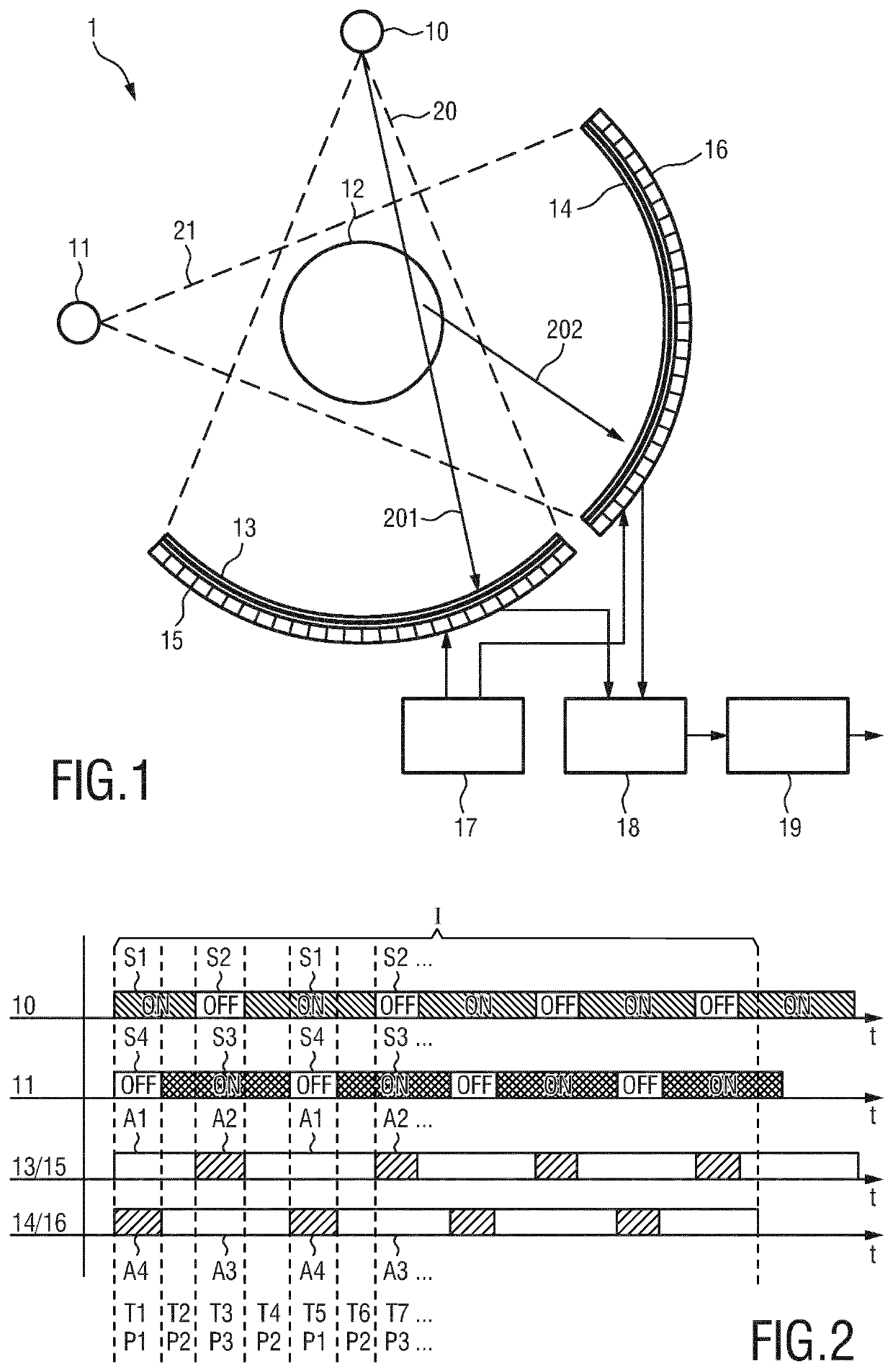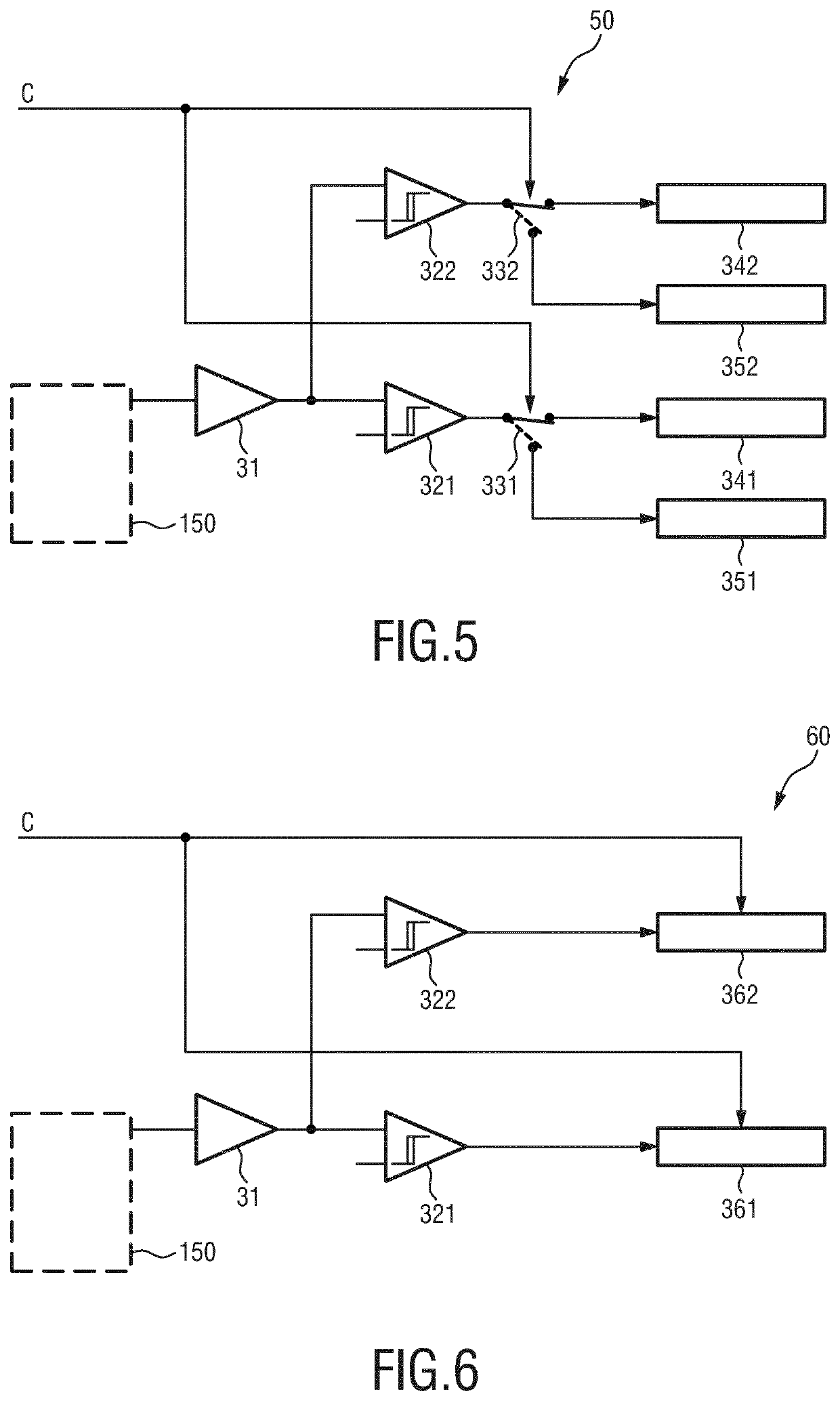CT system and CT method
a technology of ct system and ct method, applied in the field of ct system and corresponding ct method, can solve the problems of large computation effort, particularly difficult, and impinging on the wrong detector, and achieve the effect of suppressing or eliminating the negative effects of cross-scatter
- Summary
- Abstract
- Description
- Claims
- Application Information
AI Technical Summary
Benefits of technology
Problems solved by technology
Method used
Image
Examples
first embodiment
[0045]FIG. 1 shows a schematic diagram of a CT system 1 according to the present invention. It comprises two x-ray sources 10, 11, which are in this example displaced by a rotational angle of about 90°, for rotating about and concurrently or subsequently emitting radiation 20, 21 through an imaging region 12, in which an object of examination is arranged, e.g. a patient on a patient table. Two detectors 13, 14, one per x-ray source 10, 11, are arranged opposite the respective x-ray source 10, 11, for detecting radiation after penetration through the imaging region 12. Two read-out units 15, 16, one per detector 13, 14, are provided for reading out (preferably per pixel or groups of pixels) the detected radiation from the respective detector 13, 14. Further, a control unit 17 is provided for controlling said x-ray sources 10, 11 and said read-out units 15, 16. An optional scatter correction unit 18 generates scatter-corrected read-out signals from the detected radiation. Alternativel...
second embodiment
[0066]In the embodiment shown in FIG. 3 it was assumed that only one threshold is available. FIG. 4 shows a circuit diagram of a read-out unit 40 according to the present invention applying a multi-bin topology. In this embodiment, the single radiation counter 34 is replaced by a multi-bin radiation counting unit 44 comprising multiple counters 341, 342, and the single discriminator 32 is replaced by a multi-bin discriminator unit 42 comprising multiple discriminators 321, 322 (applying different thresholds) coupled to the respective counter 341, 342 to obtain spectral information for the detected radiation.
[0067]In the read-out unit 40 a single scatter counter 35 at the lowest threshold is used, considering in this case that the energy information of the scatter photons is not of primary interest. In an alternative embodiment of a read-out unit 50 shown in FIG. 5 the same degree of spectral differentiation is provided for both primary and scattered photons. For this purpose the sin...
fifth embodiment
[0076]FIG. 8 shows a circuit diagram of a read-out unit 70 according to the present invention for implementing the embodiment illustrated in FIG. 7. Based on the status of the sources 10, 11 three different enabling (control) signals E1, E2 and E3 are generated by an enabling logic 38 for enabling a respective counter 371, 372, 373. For read-out unit 15 the counter 371 is enabled during acquisition mode B3 (phase P3), the counter 372 is enabled during acquisition mode B1 (phase P1), and the counter 373 is enabled during acquisition mode B2 (phase P2). As for earlier embodiments, the radiation counters 371 and 372 are expected to be significantly smaller than the counter 373.
PUM
| Property | Measurement | Unit |
|---|---|---|
| rotational angle | aaaaa | aaaaa |
| switching time | aaaaa | aaaaa |
| switching time | aaaaa | aaaaa |
Abstract
Description
Claims
Application Information
 Login to View More
Login to View More - R&D
- Intellectual Property
- Life Sciences
- Materials
- Tech Scout
- Unparalleled Data Quality
- Higher Quality Content
- 60% Fewer Hallucinations
Browse by: Latest US Patents, China's latest patents, Technical Efficacy Thesaurus, Application Domain, Technology Topic, Popular Technical Reports.
© 2025 PatSnap. All rights reserved.Legal|Privacy policy|Modern Slavery Act Transparency Statement|Sitemap|About US| Contact US: help@patsnap.com



